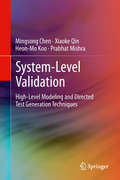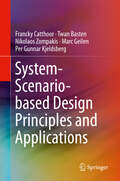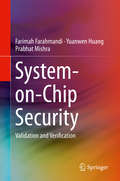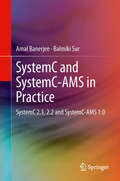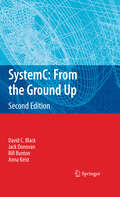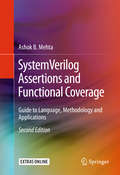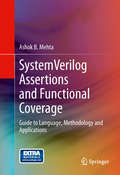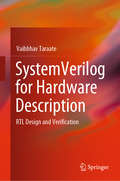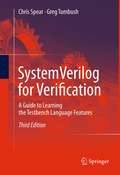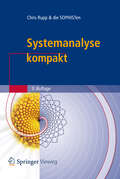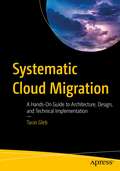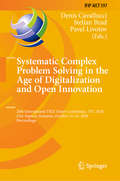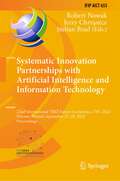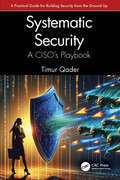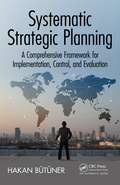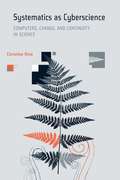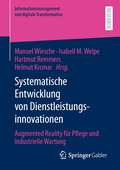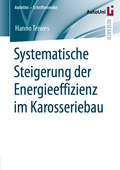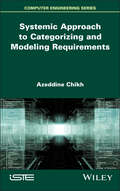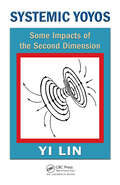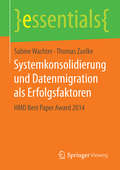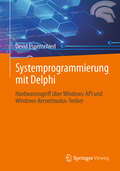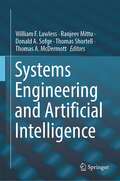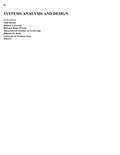- Table View
- List View
System-Level Validation
by Prabhat Mishra Heon-Mo Koo Xiaoke Qin Mingsong ChenThis book covers state-of-the art techniques for high-level modeling and validation of complex hardware/software systems, including those with multicore architectures. Readers will learn to avoid time-consuming and error-prone validation from the comprehensive coverage of system-level validation, including high-level modeling of designs and faults, automated generation of directed tests, and efficient validation methodology using directed tests and assertions. The methodologies described in this book will help designers to improve the quality of their validation, performing as much validation as possible in the early stages of the design, while reducing the overall validation effort and cost.
System-Scenario-based Design Principles and Applications
by Francky Catthoor Twan Basten Nikolaos Zompakis Marc Geilen Per Gunnar KjeldsbergThis book introduces a generic and systematic design-time/run-time methodology for handling the dynamic nature of modern embedded systems, without adding large safety margins in the design. The techniques introduced can be utilized on top of most existing static mapping methodologies to deal effectively with dynamism and to increase drastically their efficiency. This methodology is based on the concept of system scenarios, which group system behaviors that are similar from a multi-dimensional cost perspective, such as resource requirements, delay, and energy consumption. Readers will be enabled to design systems capable to adapt to current inputs, improving system quality and/or reducing cost, possibly learning on-the-fly during execution.Provides an effective solution to deal with dynamic system designIncludes a broad survey of the state-of-the-art approaches in this domainEnables readers to design for substantial cost improvements (e.g. energy reductions), by exploiting system scenariosDemonstrates how the methodology has been applied effectively on various, real design problems in the embedded system context
System-on-Chip Security: Validation and Verification
by Prabhat Mishra Farimah Farahmandi Yuanwen HuangThis book describes a wide variety of System-on-Chip (SoC) security threats and vulnerabilities, as well as their sources, in each stage of a design life cycle. The authors discuss a wide variety of state-of-the-art security verification and validation approaches such as formal methods and side-channel analysis, as well as simulation-based security and trust validation approaches. This book provides a comprehensive reference for system on chip designers and verification and validation engineers interested in verifying security and trust of heterogeneous SoCs.
SystemC and SystemC-AMS in Practice
by Amal Banerjee Balmiki SurThis book describes how engineers can make optimum use of the two industry standard analysis/design tools, SystemC and SystemC-AMS The authors use a system-level design approach, emphasizing how SystemC and SystemC-AMS features can be exploited most effectively to analyze/understand a given electronic system and explore the design space. The approach taken by this book enables system engineers to concentrate on only those SystemC/SystemC-AMS features that apply to their particular problem, leading to more efficient design. The presentation includes numerous, realistic and complete examples, which are graded in levels of difficulty to illustrate how a variety of systems can be analyzed with these tools.
SystemC: From the Ground Up, Second Edition
by David C. Black Bill Bunton Jack Donovan Anna KeistSystemC provides a robust set of extensions to the C++ language that enables rapid development of complex models of hardware and software systems. The authors focus on practical use of the language for modeling real systems, showing: A step-by-step build-up of syntax Code examples for each concept Over 8000 lines of downloadable code examples Updates to reflect the SystemC standard, IEEE 1666 Why features are as they are Many resource references How SystemC fits into an ESL methodology This new edition of an industry best seller is updated to reflect the standardization of SystemC as IEEE 1666 and other improvements that reflect feedback from readers of the first edition. The wide ranging feedback also include suggestions from editors of the Japanese and Korean language translations, professors and students, and computer engineers from a broad industrial and geographical spectrum, all who have successfully used the first edition. New chapters have been added on the SystemC Verification Library and the Transaction Level Modeling, and proposed changes to the current SystemC standard. David Black and Jack Donovan, well known consultants in the EDA industry, have teamed with Bill Bunton and Anna Keist, experienced SystemC modeling engineers, to write the second edition of this highly popular classic. As a team the authors bring over 100 years of ASIC and system design experience together to make a very readable introduction to SystemC.
SystemVerilog Assertions and Functional Coverage
by Ashok B. MehtaThisbook provides a hands-on, application-oriented guide to the language andmethodology of both SystemVerilog Assertions and SystemVerilog FunctionalCoverage. Readers will benefit from the step-by-step approach to functionalhardware verification using SystemVerilog Assertions and Functional Coverage,which will enable them to uncover hidden and hard to find bugs, point directlyto the source of the bug, provide for a clean and easy way to model complextiming checks and objectively answer the question 'have we functionallyverified everything'. Written by a professional end-user of ASIC/SoC/CPU andFPGA design and Verification, this book explains each concept with easy tounderstand examples, simulation logs and applications derived from realprojects. Readers will be empowered to tackle the modeling of complex checkersfor functional verification, thereby drastically reducing their time to designand debug. This updated second edition addresses the latest functional set releasedin IEEE-1800 (2012) LRM, including numerous additional operators and features. Additionally, many of the Concurrent Assertions/Operators explanations areenhanced, with the addition of more examples and figures. #65533; Covers in its entirety the latest IEEE-1800 2012 LRM syntax and semantics; #65533; Covers both SystemVerilog Assertions and SystemVerilog Functional Coverage language and methodologies; #65533; Provides practical examples of the what, how and why of Assertion Based Verification and Functional Coverage methodologies; #65533; Explains each concept in a step-by-step fashion and applies it to a practical real life examp≤ #65533; Includes 6 practical LABs that enable readers to put in practice the concepts explained in the book.
SystemVerilog Assertions and Functional Coverage: Guide to Language, Methodology and Applications
by Ashok B. MehtaThis book provides a hands-on, application-oriented guide to the language and methodology of both SystemVerilog Assertions and SytemVerilog Functional Coverage. Readers will benefit from the step-by-step approach to functional hardware verification, which will enable them to uncover hidden and hard to find bugs, point directly to the source of the bug, provide for a clean and easy way to model complex timing checks and objectively answer the question 'have we functionally verified everything'. Written by a professional end-user of both SystemVerilog Assertions and SystemVerilog Functional Coverage, this book explains each concept with easy to understand examples, simulation logs and applications derived from real projects. Readers will be empowered to tackle the modeling of complex checkers for functional verification, thereby drastically reducing their time to design and debug.
SystemVerilog for Hardware Description: RTL Design and Verification
by Vaibbhav TaraateThis book introduces the reader to FPGA based design for RTL synthesis. It describes simple to complex RTL design scenarios using SystemVerilog. The book builds the story from basic fundamentals of FPGA based designs to advance RTL design and verification concepts using SystemVerilog. It provides practical information on the issues in the RTL design and verification and how to overcome these. It focuses on writing efficient RTL codes using SystemVerilog, covers design for the Xilinx FPGAs and also includes implementable code examples. The contents of this book cover improvement of design performance, assertion based verification, verification planning, and architecture and system testing using FPGAs. The book can be used for classroom teaching or as a supplement in lab work for undergraduate and graduate coursework as well as for professional development and training programs. It will also be of interest to researchers and professionals interested in the RTL design for FPGA and ASIC.
SystemVerilog for Verification
by Chris Spear Greg TumbushBased on the highly successful second edition, this extended edition of SystemVerilog for Verification: A Guide to Learning the Testbench Language Features teaches all verification features of the SystemVerilog language, providing hundreds of examples to clearly explain the concepts and basic fundamentals. It contains materials for both the full-time verification engineer and the student learning this valuable skill. In the third edition, authors Chris Spear and Greg Tumbush start with how to verify a design, and then use that context to demonstrate the language features, including the advantages and disadvantages of different styles, allowing readers to choose between alternatives. This textbook contains end-of-chapter exercises designed to enhance students' understanding of the material. Other features of this revision include: New sections on static variables, print specifiers, and DPI from the 2009 IEEE language standardDescriptions of UVM features such as factories, the test registry, and the configuration databaseExpanded code samples and explanations Numerous samples that have been tested on the major SystemVerilog simulatorsSystemVerilog for Verification: A Guide to Learning the Testbench Language Features, Third Edition is suitable for use in a one-semester SystemVerilog course on SystemVerilog at the undergraduate or graduate level. Many of the improvements to this new edition were compiled through feedback provided from hundreds of readers.
Systemanalyse kompakt
by Chris Rupp Sophist GmbhSystemanalyse kompakt zeigt Ihnen die Schwerpunkte der Anforderungsanalyse im Rahmen der Software- und Systemanalyse auf. Die Anforderungsanalyse bildet das Fundament eines jeden Systementwicklungsprojektes und entscheidet daher maßgeblich über Erfolg oder Misserfolg Ihres Projektes. Gerade in der Analysephase eröffnet sich Ihnen das Potenzial zur effizienten und zielorientierten Beeinflussung der Systementwicklung: Erstellen Sie eine vollständige und eindeutige Anforderungsdefinition, bei der Aufwand und Ergebnis in optimalem Verhältnis zueinander stehen. Dabei hilft Ihnen Systemanalyse kompakt. Das Buch bringt die Haupttätigkeiten der Systemanalyse auf den Punkt. Dabei vermittelt es mit den vom International Requirements Engineering Board festgelegten Begriffen, Definitionen und Zusammenhängen neben grundlegenden organisatorischen Rahmenbedingungen zahlreiche pragmatische Ansätze, wie Sie das grundlegend notwendige Wissen - umfassend ermitteln, - verständlich dokumentieren, - effektiv verwalten - und angemessen prüfen. Lösungsvorschläge zu konkreten Problemen der Systementwicklung und praxiserprobte Tipps unterstützen Sie bei Ihrer täglichen Arbeit. So können Sie dafür sorgen, dass die Anforderungen an ein System von allen Projektbeteiligten verstanden und verwirklicht werden können.
Systematic Cloud Migration: A Hands-On Guide to Architecture, Design, and Technical Implementation
by Taras GlebThis book is your systematic cloud migration guide. Experiences shared by the author are drawn from real-life migration projects and contain practical advice, as well as step-by-step architecture, design, and technical implementation instructions using sample application code on GitLab. Following the guidance in this book will provide much needed support to your teams, and help you successfully complete the application cloud migration journey. Systematic Cloud Migration consists of four major parts. Part one starts with a fundamental introduction of cloud computing to establish the context for migration, including paradigm changes in five important areas: software application, DevSecOps, operations, infrastructure, and security. And these are the areas that the book follows throughout. Next, it introduces a real-life migration process that your team can follow. Part two presents the migration process for the application code, including architecture diagrams and presented by demo application code and supporting infrastructure in AWS cloud. Part three dives into DevSecOps and automation. In addition to concepts, a real-life migration diagram and sample pipeline code implemented with GitLab are include. Part four deals with efficient cloud operations. Each chapter has a practical structure: objectives, roles, inputs, process/activities, outputs/deliverables, best practices, and summary. There is a wealth of cloud production-grade template style artifacts that can be used as is. What You Will Learn Design applications in the cloud, including determining the design criteria (e.g., solution cost is a design criterion, same as security, and is not an afterthought)Understand the major migration areas: software development (application code, data, integration, and configuration), software delivery (pipeline and automation), and software operations (observability)Migrate each application element: client and business components code, data, integration and services, logging, monitoring, alerting, as well as configurationsUnderstand cloud-critical static application security testing (SAST), dynamic application security testing (DAST), containers compliance and security scanning, and open source dependency testingKnow the directions and implementation details on cost-efficient, automated, cloud-native software operations Who This Book Is For Primarily designed with software developers, team leads, development managers, DevOps engineers, and software architects in mind. Their day-to-day activities include architecting, designing, developing, delivering, and operating software in the cloud environment. In addition, this book will benefit infrastructure, network, security, and operations engineers, who in turn, can provide better support for the software development product teams.
Systematic Complex Problem Solving in the Age of Digitalization and Open Innovation: 20th International TRIZ Future Conference, TFC 2020, Cluj-Napoca, Romania, October 14–16, 2020, Proceedings (IFIP Advances in Information and Communication Technology #597)
by Denis Cavallucci Stelian Brad Pavel LivotovThis book constitutes the refereed proceedings of the 20th International TRIZ Future Conference on Automated Invention for Smart Industries, TFC 2020, held in Cluj-Napoca, Romania, in October 2020 and sponsored by IFIP WG 5.4. The conference was held virtually.The 34 full papers presented were carefully reviewed and selected from 91 submissions. They are organized in the following thematic sections: computing TRIZ; education and pedagogy; sustainable development; tools and techniques of TRIZ for enhancing design; TRIZ and system engineering; TRIZ and complexity; and cross-fertilization of TRIZ for innovation management.
Systematic Innovation Partnerships with Artificial Intelligence and Information Technology: 22nd International TRIZ Future Conference, TFC 2022, Warsaw, Poland, September 27–29, 2022, Proceedings (IFIP Advances in Information and Communication Technology #655)
by Stelian Brad Robert Nowak Jerzy ChrząszczThis book constitutes the refereed proceedings of the 22nd International TRIZ Future Conference on Automated Invention for Smart Industries, TFC 2022, which took place in Warsaw, Poland, in September 2022; the event was sponsored by IFIP WG 5.4.The 39 full papers presented were carefully reviewed and selected from 43 submissions. They are organized in the following thematic sections: New perspectives of TRIZ; AI in systematic innovation; systematic innovations supporting IT and AI; TRIZ applications; TRIZ education and ecosystem.
Systematic Program Design: From Clarity to Efficiency
by Yanhong Annie LiuA systematic program design method can help developers ensure the correctness and performance of programs while minimizing the development cost. This book describes a method that starts with a clear specification of a computation and derives an efficient implementation by step-wise program analysis and transformations. The method applies to problems specified in imperative, database, functional, logic, and object-oriented programming languages with different data, control, and module abstractions. Designed for courses or self-study, this book includes numerous exercises and examples that require minimal computer science background, making it accessible to novices. Experienced practitioners and researchers will appreciate the detailed examples in a wide range of application areas including hardware design, image processing, access control, query optimization, and program analysis. The last section of the book points out directions for future studies.
Systematic Security: A CISO’s Playbook
by Timur QaderIn today’s rapidly evolving digital landscape, safeguarding critical data and systems has never been more vital—or more challenging. Systematic Security: A CISO’s Playbook by Timur Qader offers a groundbreaking guide to building a resilient and scalable security practice from the ground up. Blending real-world experience with practical insights, this book lays out a phased approach to security implementation.Timur begins with describing the current state of security and the landscape security professionals find themselves in that offer both opportunity and risk. He goes on to systematically address strategic design, operational efficiency, risk-based modeling, and a rapidly growing regulatory landscape. This essential resource provides step-by-step strategies for implementing a comprehensive security framework. Whether you're launching a new security program or transforming an existing one, this book delivers actionable insights on governance, compliance, and advanced security operations.Drawing on years of hands-on experience, Timur shares practical advice on: Establishing a structured roadmap with clear milestones and deliverables. Building effective governance and compliance teams to address evolving regulations. Developing security operations through advanced techniques like Zero Trust and Data Protection Capabilities. Navigating complex relationships with stakeholders, executives, and regulators. Creating metrics and scorecards to measure and continuously improve security posture. More than just a technical manual, Systematic Security is a leadership toolkit for today’s security executives. It highlights the mindset, collaboration, and communication skills needed to succeed in high-pressure environments. With tips on presenting to boards, handling audits, and managing compliance, this book prepares readers for the challenges of modern cybersecurity leadership.Whether you’re an aspiring CISO, a security professional, or a business leader looking to fortify your organization’s defenses, Systematic Security delivers the strategies and tools to create lasting security excellence.Timur Qader’s candid, experience-driven approach ensures this book is not just informative but indispensable for anyone serious about protecting data, systems, and reputations in a world of escalating security threats.Prepare to lead with confidence, foster innovation, and build a future-proof security strategy that aligns with organizational goals and industry best practices. With Systematic Security, success isn’t just a possibility—it’s a repeatable process.
Systematic Strategic Planning: A Comprehensive Framework for Implementation, Control, and Evaluation
by Hakan ButunerThis book provides a complete set of practical strategic planning techniques and tools. Readers are guided in identifying how and in what circumstances they might use particular tools, and in targeting them directly at achieving effective results. Systematic Strategic Planning consists of a framework of phases through which each project passes, a pattern of procedures for straight-forward planning and the fundamentals involved in any strategic planning project. The book is designed to be simple to understand and easy to use.
Systematics as Cyberscience: Computers, Change, and Continuity in Science
by Christine HineAn exploration of the use of information and communication technologies by biologists working in systematics (taxonomy) and the dynamics of change and continuity with past practices in the development of systematics as a cyberscience.
Systematische Entwicklung von Dienstleistungsinnovationen: Augmented Reality für Pflege und industrielle Wartung (Informationsmanagement und digitale Transformation)
by Helmut Krcmar Isabell M. Welpe Manuel Wiesche Hartmut RemmersDieser Sammelband zum Projekt „Augmented Reality in flexiblen Dienstleistungsprozessen" (ARinFLEX) zeigt Anwendungsfälle für Dienstleistungsinnovationen in Pflege und industrieller Wartung auf. Die Autoren entwickeln Ideen, Konzepte und Prototypen für innovative Dienstleistungen mittels Augmented Reality und evaluieren diese in verschiedenen Kontexten. Der Sammelband bietet Grundlagen, Kontext und methodische Unterstützung zur Digitalisierung von Dienstleistungen in Pflege und industrieller Wartung.
Systematische Steigerung der Energieeffizienz im Karosseriebau (AutoUni – Schriftenreihe #150)
by Hanno TeiwesDie vorliegende Dissertation präsentiert ein Konzept zur Steigerung der Energieeffizienz im Karosseriebau um durchschnittlich 10-15%. Die dafür benötigte Energietransparenz wird durch die strukturierte energetische Analyse bestehender Karosseriebauanlagen erreicht. Weiterhin besteht bereits im Karosseriebauplanungsprozess die Möglichkeit einer Energieprognose der zu planenden Arbeitsgruppen als auch des energetischen Lastprofils. In Abhängigkeit der energetischen Bewertung werden mit Hilfe eines Expertensystems entsprechend zu ergreifende Maßnahmen dem Planer zur Verfügung gestellt.
Systemic Approach to Categorizing and Modeling Requirements (ISTE Invoiced)
by Azeddine ChikhCurrent categorizations of software requirements are highly ambiguous and inconsistent, mainly due to the lack of a clear, common framework for defining software elements and relevant environmental factors. This book overhauls the traditional approach by proposing an innovative systemic method for categorizing and modeling software requirements. It introduces an unprecedented frame of reference, putting an end to divergent interpretations by precisely defining software elements and environmental factors. This framework forms an indispensable basis for all the other components of this approach: a redefinition of requirements, a hybrid categorization that combines several taxonomies and scales, a metadata model used to qualify requirements, and a multi-view model that represents all possible categories of requirements. By adopting this new approach, professionals will be able to improve the clarity, precision and relevance of their specifications, and thus optimize the success of their software projects.
Systemic Yoyos: Some Impacts of the Second Dimension (Systems Evaluation, Prediction, and Decision-Making)
by Yi LinA Novel Method to Analyze Problems and Encourage Systemic ThinkingReal-Life Case Studies Illustrate the Application of the Systemic Yoyo Model in Diverse AreasWritten by the co-creator of the systemic yoyo model, Systemic Yoyos: Some Impacts of the Second Dimension shows how the yoyo model and its methodology can be employed to study many unsettled
Systemkonsolidierung und Datenmigration als Erfolgsfaktoren: HMD Best Paper Award 2014 (essentials)
by Sabine Wachter Thomas ZaelkeDieses essential geht präzise auf die Anforderungen und Lösungsansätze in Datenmigrations- und Konsolidierungsszenarien im SAP-Umfeld ein und präsentiert Fallbeispiele von SAP-Kunden. Der Beitrag unterstützt Unternehmen, die vor Fusionen, Zu- oder Verkäufen oder Umstrukturierungsvorhaben stehen und effiziente und verlässliche Lösungen zur Datenmigration benötigen, um die Organisationsstrukturen und Prozesse innerhalb ihrer Systemlandschaft an die betrieblichen Veränderungen anzupassen. Die Autoren zeigen, wie Unternehmen ihre Systemlandschaft harmonisieren und konsolidieren können und somit einheitliche Strukturen etabliert, die Systemkomplexität reduziert und damit der Geschäftsbetrieb verbessert werden können.
Systemprogrammierung mit Delphi: Hardwarezugriff über Windows-API und Windows-Kernelmodus-Treiber
by Devid EspenschiedWährend ständig neue Technologien und Schnittstellen die Softwareentwicklung mit Delphi begleiten, führt Sie dieses Buch in die Systemprogrammierung ein, die auch heute noch einen häufig unterschätzten Stellenwert hat. Systemprogrammierung kann sehr komplex sein und setzt fortgeschrittene Kenntnisse voraus. Mit der richtigen Methodik lässt sich das System besser beherrschen und ein besseres Systemverständnis erreichen. Dadurch sind viele Systeminformationen fundierter und umfassender ermittelbar,als es mit Windows-Bordmitteln möglich wäre. Nach einer Einführung in die Systemprogrammierung und Windows-Architektur werden Delphi-Zugriffe auf API, WMI, Registrierung, SMBIOS und Prozessor ausführlich besprochen. Weiterhin erfolgt die Entwicklung eines Windows-Kernelmodus-Treibers mit Microsoft Visual Studio, der auch unter Windows den Hardwarezugriff ermöglicht. Darauf aufbauend wird eine Beispielanwendung entworfen, die u.a. präzise Angaben zu Prozessoren mitsamt deren Temperatursensoren, Speichermodulen und PCI-Geräten bietet – ideal als praxisnahe Ergänzung zu den theoretischen Inhalten.
Systems Engineering and Artificial Intelligence
by Ranjeev Mittu William F. Lawless Donald A. Sofge Thomas Shortell Thomas A. McDermottThis book provides a broad overview of the benefits from a Systems Engineering design philosophy in architecting complex systems composed of artificial intelligence (AI), machine learning (ML) and humans situated in chaotic environments. The major topics include emergence, verification and validation of systems using AI/ML and human systems integration to develop robust and effective human-machine teams—where the machines may have varying degrees of autonomy due to the sophistication of their embedded AI/ML. The chapters not only describe what has been learned, but also raise questions that must be answered to further advance the general Science of Autonomy. The science of how humans and machines operate as a team requires insights from, among others, disciplines such as the social sciences, national and international jurisprudence, ethics and policy, and sociology and psychology. The social sciences inform how context is constructed, how trust is affected when humans and machines depend upon each other and how human-machine teams need a shared language of explanation. National and international jurisprudence determine legal responsibilities of non-trivial human-machine failures, ethical standards shape global policy, and sociology provides a basis for understanding team norms across cultures. Insights from psychology may help us to understand the negative impact on humans if AI/ML based machines begin to outperform their human teammates and consequently diminish their value or importance. This book invites professionals and the curious alike to witness a new frontier open as the Science of Autonomy emerges.
Systems Analysis And Design
by Alan Dennis Roberta M. Roth Barbara Haley WixomThe 6th Edition of Systems Analysis and Design continues to offer a hands-on approach to SAD while focusing on the core set of skills that all analysts must possess. Building on their experience as professional systems analysts and award-winning teachers, authors Dennis, Wixom, and Roth capture the experience of developing and analyzing systems in a way that students can understand and apply. With Systems Analysis and Design, 6th Edition, students will leave the course with experience that is a rich foundation for further work as a systems analyst.
